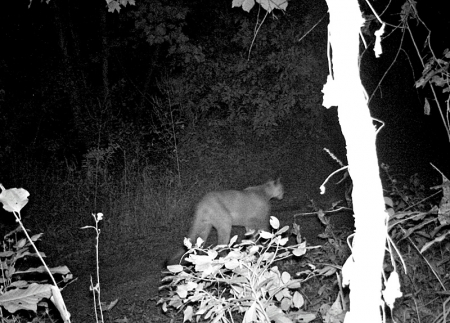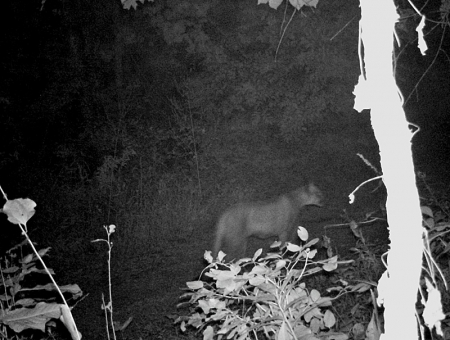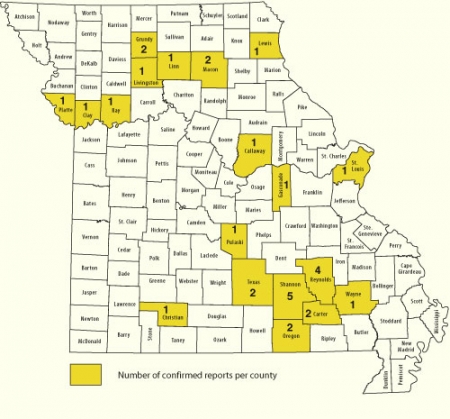Last weekend, one of the Park’s Law Enforcement Rangers wanted to try out a new game camera, so he placed it along a fairly well used dirt road near one of our campgrounds. There was a small buck photographed the first night; the next day it was traffic along the road and the inevitable empty frames triggered by birds or the wind. Then on the second night, this guy triggered the camera.
Oooh, that’s a mountain lion, isn’t it? Let’s see – consistent base color (no spots,) a long tail with a black tip and dark markings on the backs of the ears. Nope, that aint no bobcat. There’s not enough sense of scale in the photo to really say just how big it is, but it looks like an adult to me.
But hold on, we’re not finished yet. The next day showed more traffic, including some folks on bicycles, and then when it was dark again, the camera caught this image:
Two nights in a row. Sweet. And he might have even returned for a third night, but we can’t know because the camera was pulled the next day (before the photos had been downloaded.) Makes me want to go and have a look around, that’s for sure.
While still a rare event, Missouri mountain lion sightings are becoming decidedly more common. Missouri’s last historically recorded mountain lion was killed in the bootheel in 1927. But the Missouri Department of Conservation (MDC) has confirmed 31 mountain lions since 1994, 21 in the last two years. Part of that surge in confirmed sightings is undoubtedly due to the prevalence of game cameras, but those have been around for a good while, leaving us with the likelihood that the mountain lion population in Missouri is increasing. MDC’s company line is that these are primarily young males, dispersing from breeding populations to the west. The evidence supports this since the cats that MDC has physically examined have been predominately male and DNA samples from four of them track back to the Black Hills of South Dakota (2,) central Montana and Colorado. So far, there’s nothing to suggest the presence of a breeding population, but I wouldn’t be surprised for a kitten or two to show up before long.
The counties that include the majority of the park (Carter and Shannon) and the surrounding counties are definitely the hotspot for confirmed sightings. One of those was last summer, when one was spotted crossing Main Street in Van Buren. Now Van Buren is not very big (population is just over 800,) but still, this was not a shy kitty. After crossing the street, the cat passed between the bank and drug store before clearing a 7-foot fence topped with barbed wire. Hair caught in the fence allowed MDC to confirm the sighting. And, just to get to Main Street and based on his direction of travel, he had to cross 4-lane Highway 60 and nearly a half mile of residential area. No, not shy at all (sneaky though, since he did get that far without being spotted.)
And happily for me, unlike the more numerous black bears and much more numerous river otters, I have seen a mountain lion. Two actually. The most recent was a “blink and you missed it” encounter along a dirt road in the Mark Twain National Forest back in May. Frankly, I wouldn’t swear that it was a mountain lion, but I believe it was. The other was almost 10 years ago when I saw one leisurely walk across Highway 60 just west of the Carter/Shannon county line. I got to watch this kitty for fifteen seconds from less than 200’ in the middle of the day and I have NO doubt about it’s identity.
And then there was the very small whitetail fawn I found covered with sticks and leaves back in June, 2002. The covering, or caching, behavior is indicative of mountain lions, but bears and bobcats will do it as well. There was no visible injury to the deer, so it probably wasn’t a bear, but it was small enough that I couldn’t rule out a bobcat as the killer. If I had it to do over again, I’d skin the carcass to look for bite marks in the neck area. Still a pretty cool find.
It’s still a long shot, but right now is the best time in almost a hundred years to see a mountain lion in Missouri and the odds are getting better. So keep your eyes open.


